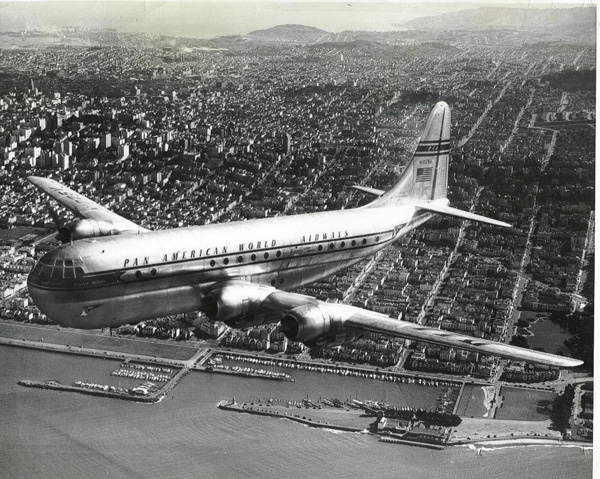
|
 |
Boeing 377 Stratocruiser |
 |
 |
 |
 |
 |
|---|---|---|---|---|---|---|---|
 |
 |
 |
 |
 |
|||
 |
||
|
Every so often an aircraft appears which does more for aviation than its limited production numbers would indicate and this was certainly the case with the Stratocruiser, for only 56 were produced. Its development began in 1944 with the first flight of a military aircraft, later named the C-97 Stratofreighter. This was a large-capacity transport of striking design, although it embodied the wings, tail unit, undercarriage and other components of the Boeing B-29 Superfortress bomber. A total of 888 of all variants were built, many becoming KC-97 refueling tankers and serving with the United States Air Force and others.1 |
| The Stratocruiser was simply a civil airliner version of the Stratofreighter. It had the same B-29 parts married to the bulbous fuselage, and had accommodations for between 55 and 100 passengers or 28 sleeping berths and five seats. All versions featured a lower-deck lounge and bar, an innovation which, combined with a long range and high speed, set a new standard for luxurious air travel. |
|
As with many great American aircraft, the Stratocruiser was first introduced into service by Pan American World Airways in 1949 flying between San Francisco, California and Honolulu, Hawaii. Pan American placed the first order for 20 Stratocruisers, worth $24 million and eventually owned 29 of all Stratocruisers built.2 Five other airlines operated the type and it was Boeing's first significant success selling passenger planes to airlines in other countries. BOAC took delivery of its first aircraft in the same year as Pan Am, and began transatlantic services in December. The Stratocruiser remained as flagships on the Atlantic run until forced out of service by the first generation of long-range
Boeing 707 jet airliners.

The Stratocruiser featured an extra-wide passenger cabin and a circular staircase that led to a lower-deck beverage lounge. The sleeper version of the Stratocruiser was equipped with 28 upper-and-lower bunk units. |
| Specifications: | |
|---|---|
| Boeing 377 Stratocruiser | |
| Dimensions: | |
| Wing span: | 141 ft 3 in (43.05 m) |
| Length: | 110 ft 4 in (33.63 m) |
| Height: | 38 ft 3 in (11.66 m) |
| Wing Area: | 1,769 sq ft (164.34 sq m) |
| Weights: | |
| Empty: | 83,500 lb (37,875 kg) |
| Maximum T/O: | 145,800 lb (66,134 kg) |
| Performance: | |
| Maximum Level Speed: | 375 mph (604 km/h) @ 25,000 ft (7,620 m) |
| Cruising Speed: | 340 mph (547 km/h) @ 25,000 ft (7,620 m) |
| Service Ceiling: | Above 32,000 ft (9,755 m) |
| Maximum Range: | 4,200 miles (6,759 km) |
| Powerplant: | |
|
Four Pratt & Whitney R-4360 Wasp Major, 3,500 hp (2,610 kw), 28 cylinder, air-cooled, radial engines. |
|
Endnotes:
|
1. Peter M. Bowers. Boeing Aircraft Since 1916 New York: Funk & Wagnalls, 1968. 314. 2. R. E. G. Davies. Pan Am, An Airline and its Aircraft. New York: Orion Books, 1987. 56. |
© The Aviation History On-Line Museum. All rights reserved.
Created February 23, 1999, Updated October 11, 2013.